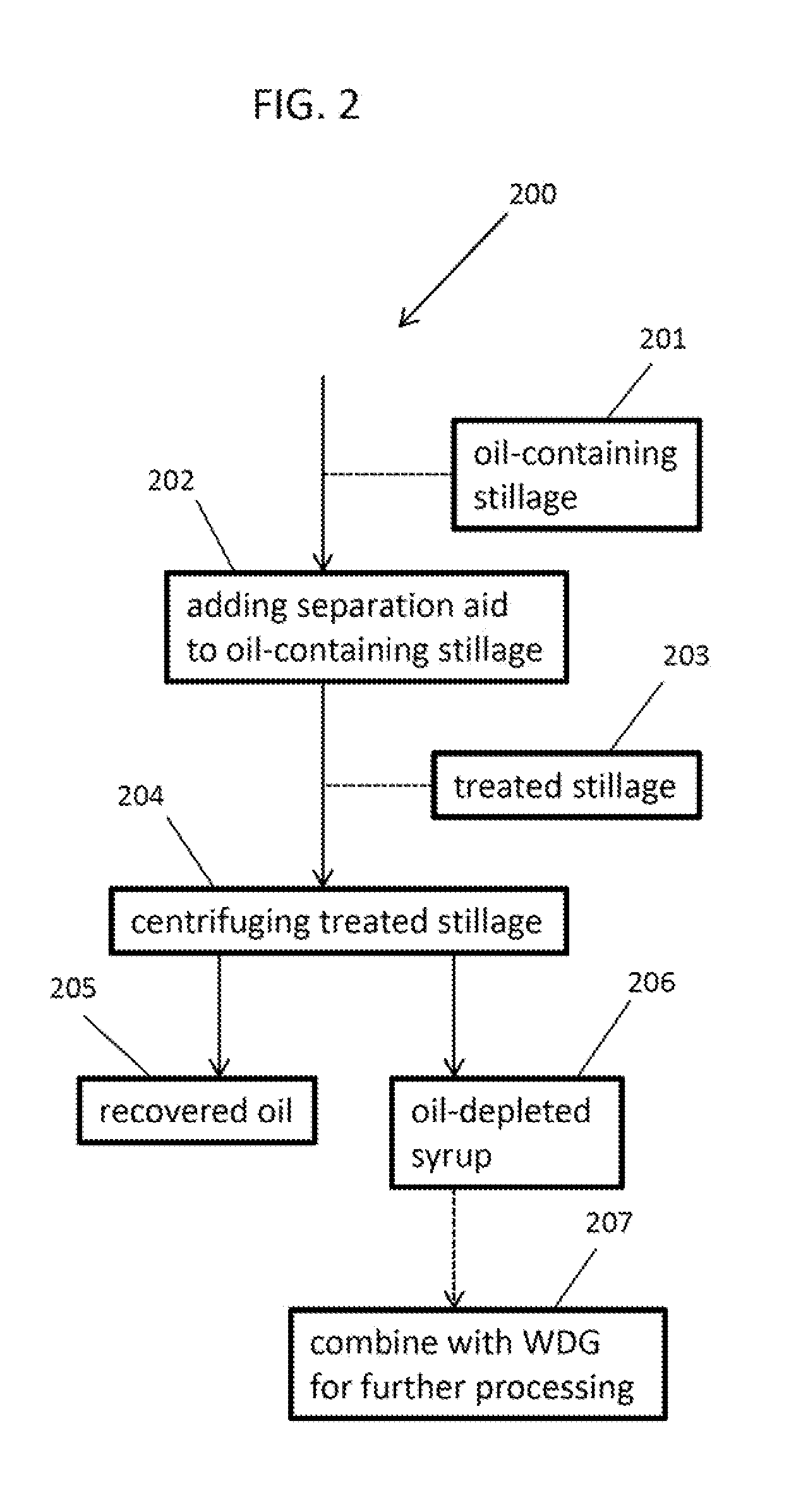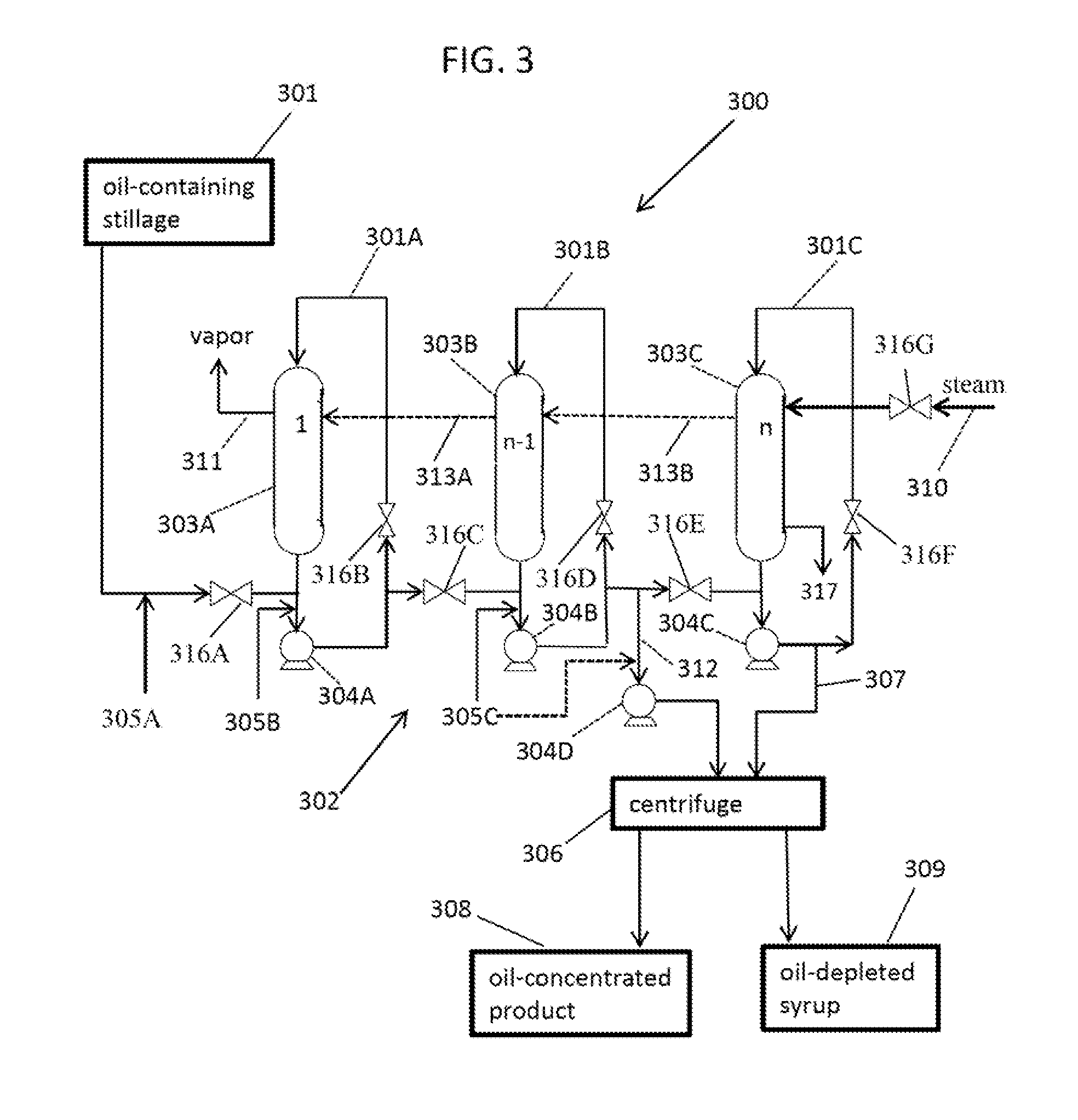Methods And Systems For Bio-Oil Recovery And Separation Aids Therefor
a bio-oil and separation aid technology, applied in the direction of fatty oil/acid recovery from waste, fatty substance recovery, centrifuge, etc., can solve the problems of potential safety issues, use of these compounds, and efforts to recover valuable oil from stillage that have encountered significant obstacles, so as to reduce the surface tension of liquids and reduce the surface tension
- Summary
- Abstract
- Description
- Claims
- Application Information
AI Technical Summary
Benefits of technology
Problems solved by technology
Method used
Image
Examples
example 1
[0073]Bench testing was performed on stillage (16-18 wt % solids) coming from a fifth evaporator of an 8-stage evaporator used in a bioethanol production facility using corn feedstock, such as shown in FIGS. 1 and 3 herein and generally as described in the incorporated '182 patent. The withdrawn samples of stillage were mixed with various treatment compositions indicated in Table 1 by manually stirring the stillage with selected dosages of treatment composition, then pouring the resulting blends into measuring tubes, and the recovered oil products were observed and compared for clarity and volume. In Table 1, the treatment compositions 1 and 2 contained at least lecithin and oil. These compositions are separation aids which represent examples of the present invention. The other treatment compositions contained other combinations of chemicals and are comparison examples.
TABLE 1TreatmentTreatment CompositionComposition No.DosageFormulation (in wt %)Comparison 1*400 ppmHydrogenated soy...
example 2
[0075]Additional bench testing was performed on stillage (16-18 wt % solids) coming from a fifth evaporator of an 8-stage evaporator used in a bioethanol production facility using corn feedstock, such as shown in FIGS. 1 and 3 herein and generally as described in the incorporated '182 patent. The withdrawn samples of stillage were mixed with various treatment compositions indicated in Table 2 (amounts provided in wt %) by manually stirring the stillage with the added treatment composition, pouring the resulting blends into measuring tubes, and visually comparing the recovered oils for clarity and volume to a Baseline product. The baseline product was a stillage sample treated with the Comparison 1 treatment composition as described in Example 1. Product 33 was stillage treated with the treatment composition 2 described in Example 1. All samples of stillage were dosed with 30 μl of treatment composition which is equivalent to approximately 550 ppm. Table 2 shows the results of the pe...
example 3
[0077]Additional bench testing was performed on stillage (16-18 wt % solids) coming from a fifth evaporator of an 8-stage evaporator used in a bioethanol production facility using corn feedstock, such as shown in FIGS. 1 and 3 herein and generally as described in the incorporated '182 patent. The withdrawn samples of stillage were mixed with various treatment compositions manually stirring at the same dosage, pouring the resulting blends into measuring tubes, and visually comparing the recovered oils for clarity and amount to a Baseline product. The Baseline product was a stillage sample treated in-line at an evaporator pump with the Comparison 1 treatment composition as described in Example 1. Treated products designated 13864, 13865, 13866, and 1991 were prepared by treatment of withdrawn samples of the stillage from the evaporator with four different compositions of separation aids of the present invention. The Baseline product had its treatment composition added with aid of a pu...
PUM
 Login to View More
Login to View More Abstract
Description
Claims
Application Information
 Login to View More
Login to View More - R&D
- Intellectual Property
- Life Sciences
- Materials
- Tech Scout
- Unparalleled Data Quality
- Higher Quality Content
- 60% Fewer Hallucinations
Browse by: Latest US Patents, China's latest patents, Technical Efficacy Thesaurus, Application Domain, Technology Topic, Popular Technical Reports.
© 2025 PatSnap. All rights reserved.Legal|Privacy policy|Modern Slavery Act Transparency Statement|Sitemap|About US| Contact US: help@patsnap.com



